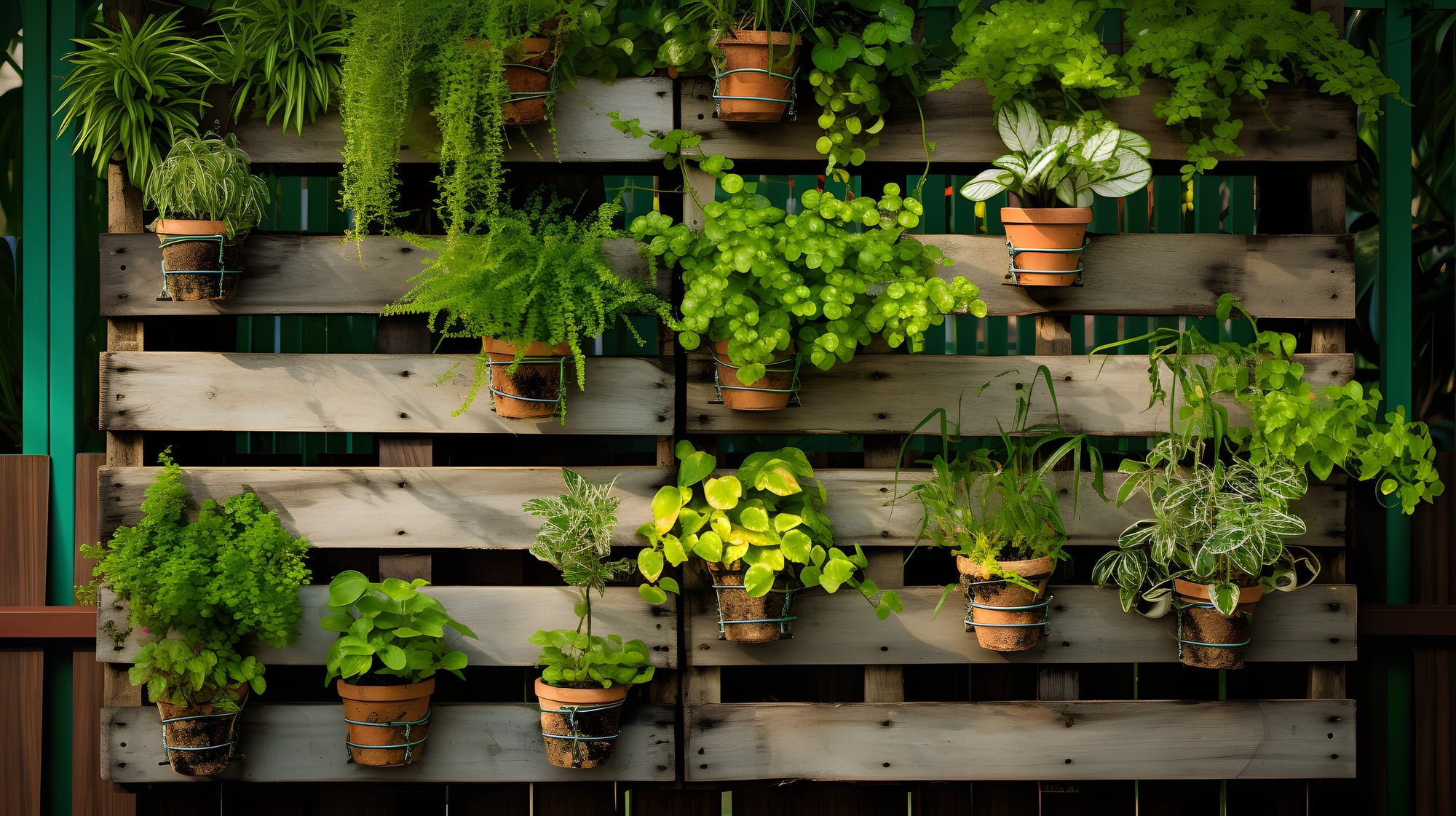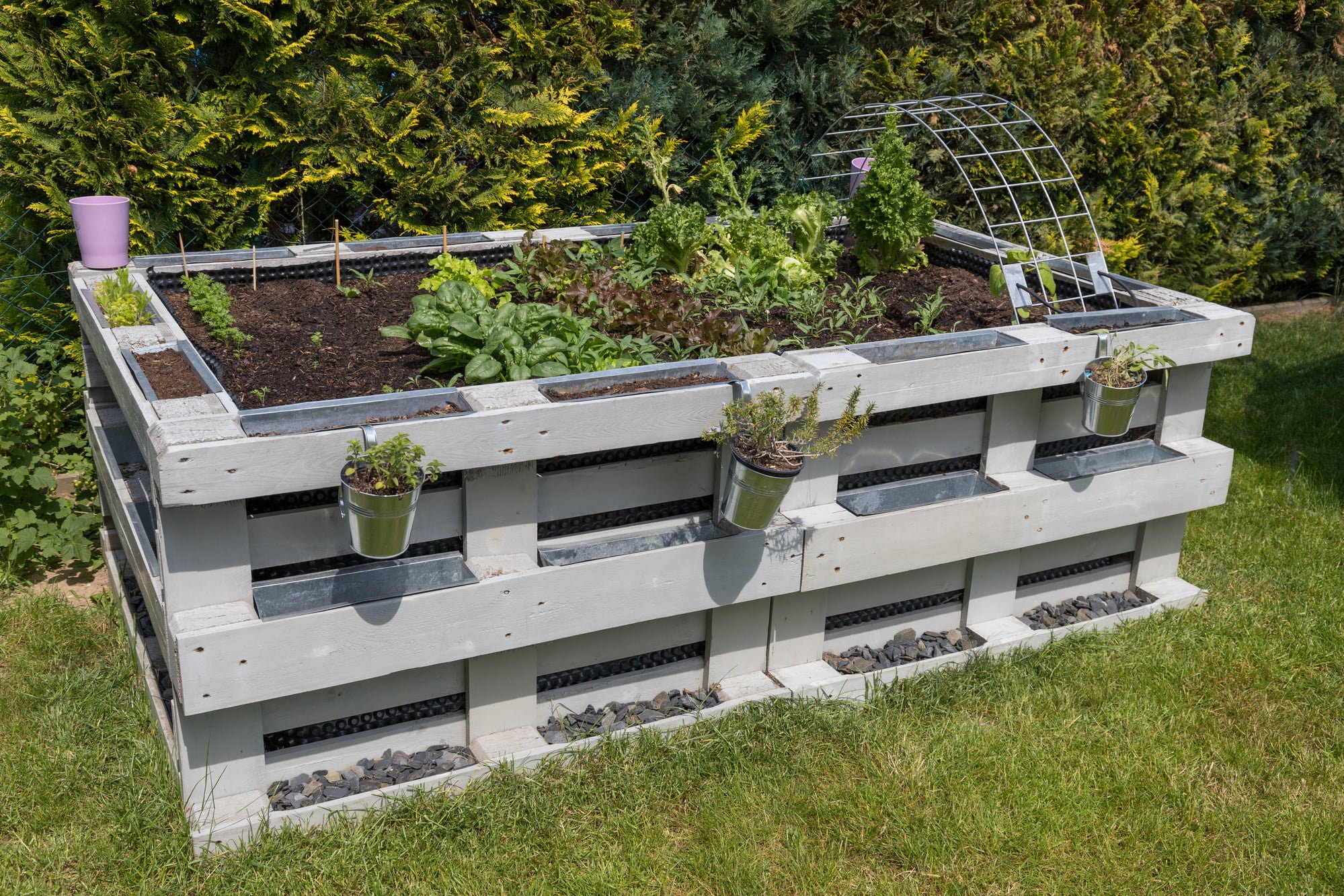
Deterred by limited space or a tight budget but longing for a garden? The charm of lush greens, colorful flowers, and fresh herbs’ aroma is no longer a distant dream. Pallet gardens are growing in popularity, offering an eco-friendly and creative way to care for plants even in small spaces. With this trend, turning even a small corner of your space into a thriving green nook is easier than ever.
The solution is surprisingly simple and lies in giving a new purpose to everyday materials. One of the keys to this innovative gardening technique is using wood pallets for shipping. Often discarded after their primary use, these wooden elements become your garden’s building blocks. In the upcoming sections, you’ll learn how to utilize these wooden structures to create a sustainable oasis without burdening your finances.
To begin your journey into pallet gardening, let’s first understand what pallets are and how they can be repurposed into a garden’s foundations.

Pallets: Building Your Garden
Pallets are more than just transport tools; they’re versatile building blocks for gardening. In do-it-yourself (DIY) gardening, they take on an exciting new life. These flat wooden structures, typically made of several slats of wood, are the key to creating a sustainable and budget-friendly green space.
- A Close Look: They are wooden platforms that support goods during transport, allowing easy lifting by forklifts, pallet jacks, or other lifting devices.
- Types Of Pallets: Most options, typically made from softwood, are commonly used. They are often readily available at little to no cost from local retailers. Plastic variants, less common for yard use, offer advantages such as resistance to weather and pests. Though metal models are less common in outdoor spaces due to their weight and potential for rust, they highlight the variety of materials available.
- Safety Considerations: Select heat-treated wood pallets, inspecting for cracks, loose nails, and contamination.
By understanding what they are, recognizing different types, and adhering to safety considerations, you’re well on your way to building your garden.
Now that you’re familiar with pallets and their potential, you might be wondering why they are an ideal choice for gardening. Let’s explore the reasons next.
Why Use Pallets?
Why choose wood pallet racks for your garden? They offer creativity, sustainability, and affordability. The reasons include:
- Recycling And Sustainability: Transforming pallets into planters promotes reuse, reduces waste, and supports environment-friendly forest management.
- Cost-Efficiency: They are often free or inexpensive, making this an affordable option. Many local businesses may be willing to donate or sell their used pallets cheaply.
- Versatility And Availability: Pallets offer many design possibilities and are readily available in most areas. They can be transformed into various shapes and styles to suit individual preferences.
- Ease Of Use: These wooden structures are simple to work with, even for beginners. Basic tools and a little creativity are all you need to get started.
Embracing these advantages sets the stage for a truly unique and environmentally conscious yard.
With the benefits of using pallets clear, it’s time to gather the essential tools and materials to start your garden.
Tools And Materials Required
Starting a special green space requires some basic tools and materials. Gathering these items ensures a smooth start to your project. These essentials fall into tools, pallet selection, and additional materials.
Necessary Tools
You’ll need the following essential tools:
- Hammer: For assembling the pallet or making necessary adjustments.
- Nails Or Screws: To secure them together or attach additional features.
- Saw: For cutting to the desired size or shape.
- Protective Gloves: To ensure safety while handling the wood and tools.
- Safety Glasses And Mask: Use safety glasses and a mask when cutting or sanding wood to protect against dust and debris.
Types Of Pallets And How To Select Them
Choosing the right pallets is crucial. Look for:
- Untreated Wood: To ensure safe plant growth, choose those marked with ‘HT’ (heat-treated) and avoid those with ‘MB’ (methyl bromide).
- Sturdy Construction: Look for well-built pieces free from significant damage.
- Proper Size: Select those that fit your space and plan according to your design.
Other Materials
Additional materials to bring your garden to life include:
- Soil: Quality soil appropriate for the plants you want to grow. Consider a mix of potting soil and compost for nutritional balance.
- Plants: Choose a variety of plants that suit your climate and design.
- Watering Can: For precise watering, especially in the early stages of growth.
- Tarp Or Landscape Fabric: Useful for vertical designs to keep the soil in place.
- Paint Or Stain (Optional): Outdoor-grade, non-toxic paint or stain if you wish to color or finish the pallets.
Remember to keep safety in mind as you assemble these essentials. Equipped with the right tools and materials, you’ll be well-prepared to take on the exciting challenge of building your green space.
Once you’ve assembled the necessary tools and materials, you’re ready to start building your pallet garden. Here’s a detailed guide next.

Step-By-Step Guide To Building A Pallet Garden
Building a pallet garden is a rewarding process that can be completed in five main stages:
- Preparing The Pallet: Start by selecting pieces free of chemicals, then clean it, removing any debris or loose nails. Sand down rough or splintering edges and consider applying a non-toxic sealant to prolong its lifespan. Ensure that the pallet is structurally sound and free of pests.
- Designing The Layout: Assess the sunlight’s direction and amount, choose plants that fit your climate and preferences, and sketch a layout. Outline where each plant will go, considering height, spacing, and companion planting. Think about seasonal changes, water drainage, and the growth pattern of the plants.
- Adding Soil And Plants: Use quality soil that suits your chosen plants and fill the pallet’s slats. Place your plants carefully, following your design, and water them initially to help them settle. Consider using compost or fertilizer to enrich the soil and support plant growth.
- Maintaining The Garden: Develop a regular care routine, including adjusting your watering schedule based on your plants’ needs, pruning, weeding, and monitoring for signs of pests or diseases. Consider seasonal changes and extreme weather if necessary.
- Adding Additional Features: Enhance your space with functional and aesthetic features. A drip watering system can make watering more efficient. Decorative landscaping elements like stones, statues, or other outdoor art add visual appeal. Additional planting spaces with pallet tiers or containers can create a more complex and engaging area.
With these thorough steps, your garden can bloom into a thriving oasis reflecting your creativity and sustainability commitment. It’s an ongoing path of learning and growth where you can continually adapt and optimize your garden to your evolving tastes and the changing seasons.
Building your pallet garden is not only rewarding but also comes with various benefits. Let’s take a closer look next.
Benefits Of A Pallet Garden
Pallet gardens provide benefits that appeal to enthusiasts, including:
- Environmental Impact: Utilizing wood structures reduces waste and promotes sustainability, and using organic materials and practices further enhances eco-friendliness.
- Space Saving: These gardens are perfect for small spaces, balconies, or urban living, and vertical designs can maximize planting space without consuming a lot of room.
- Aesthetic Appeal: Customizable designs add a unique and creative touch to your space, and incorporating various plant types and decorations can create visual harmony.
- Enhancing Home Value: A well-designed pallet garden increases curb appeal, and sustainable practices can attract eco-conscious buyers.
These benefits make pallet gardens a fantastic addition to any home. While there are many benefits to a pallet garden, there are also some common mistakes to watch out for. Here’s how to avoid them in the next section.
Common Mistakes And How To Avoid Them
A successful pallet project requires careful planning and execution. Here are common mistakes to avoid:
- Selecting Chemically Treated Pallets: Avoid selecting chemically treated or contaminated pallets by checking for stamps or labels indicating the pallet’s treatment method.
- Lack Of Planning: Consider factors like location, sunlight, soil quality, plant compatibility, drainage, accessibility, and how the area will evolve through the seasons.
- Inadequate Care And Maintenance: Develop a regular watering and trimming schedule, monitor for pests and diseases, and understand the specific needs of your preferred plants for optimal growth.
By sidestepping these pitfalls, you’re setting the stage for a thriving and eco-friendly sanctuary that reflects your style, values, and environmental commitment. Now that you have the know-how, it’s time to roll up your sleeves and cultivate your green oasis.
A successful garden is more than just a private joy; it can be a community asset. Let’s explore how to engage others and enjoy your green refuge fully.
Community Engagement And Enjoying Your Pallet Garden
Your pallet garden can be a personal oasis and a community focal point. Here’s how:
- Sharing Your Journey: Documenting and sharing your pallet garden’s progress on social media or community forums can inspire others and create connections with fellow enthusiasts.
- Educational Opportunities: Your pallet garden can be an educational tool for children and community members, teaching them sustainability, recycling, and gardening basics.
- Community Involvement: Consider hosting community workshops or tours to foster local involvement in your project.
- Personal Enjoyment: Don’t forget to take time to enjoy your yard. Whether it’s a quiet moment with a cup of tea, a family meal with fresh herbs, or a cheerful gathering with friends, your pallet oasis offers endless opportunities for relaxation and enjoyment.
Integrating these aspects makes your garden a personal project and a vibrant part of your community and daily life, enhancing connections, well-being, and shared values.
Concluding Thoughts
Explore the versatile and budget-friendly world of pallet gardening. The process emphasizes recycling, creativity, and proper planning, making it accessible to every homeowner. With the right tools and approach, you can cultivate your green thumb and enjoy the flourishing rewards of your green refuge.
